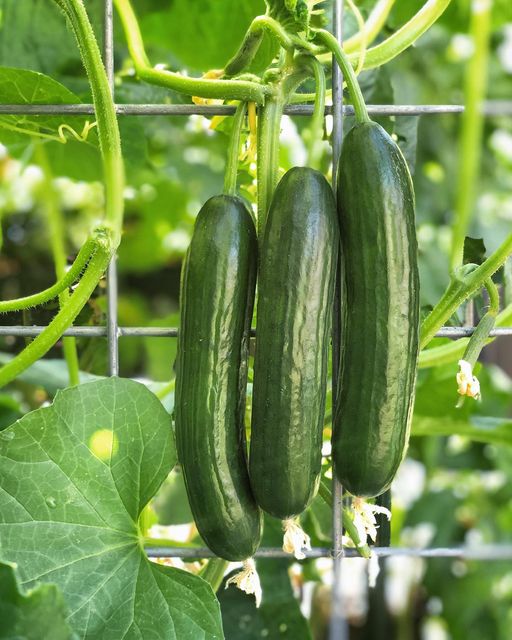
Fellow green thumbs! Are you yearning for a bumper crop of crunchy, homegrown cucumbers? Look no further! In this ultimate guide, we’ll dive into the world of growing cucumbers in containers from seed, and I’ve got 10 game-changing tips to boost your yield and make your cucumbers the talk of the town.
Table of Contents
Tip 1 – Choose the Perfect Containers
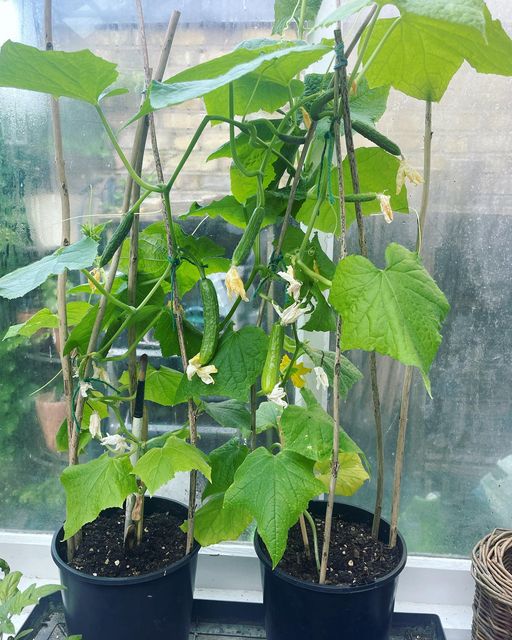
Whether you’re a newbie or a green-thumb veteran, selecting the perfect container lays the groundwork for a fruitful and satisfying cucumber-growing journey. So, let’s get started!
Size Matters:
When it comes to cucumber containers, size truly does matter. Cucumbers are vigorous growers, and they need plenty of space to stretch their roots and spread their lush foliage. Opt for containers that are at least 12 to 18 inches deep and wide, providing ample room for their robust growth. A spacious container ensures your cucumber plants won’t feel cramped, allowing them to flourish and produce a bountiful harvest.
Drainage Delight:
Drainage is a cucumber’s best friend. No cucumber wants to be stuck with soggy feet! Ensure your chosen container has sufficient drainage holes to allow excess water to escape. Proper drainage prevents waterlogged soil, which can lead to root rot and other woes that no cucumber plant should endure. If you find a container you love without drainage holes, consider drilling some yourself to ensure your cucumbers thrive.
Material Magic:
Cucumber containers come in various materials, each with its advantages and drawbacks. Terracotta containers are classic and aesthetically pleasing, but they tend to dry out faster and may require more frequent watering. Plastic containers, on the other hand, retain moisture better and are lightweight, making them easy to move around. Whichever material you choose, just make sure it suits your specific gardening needs and climate.
Climbing Cucumbers? Go Vertical!
If you’re growing climbing cucumber varieties like English cucumbers, it’s a great idea to opt for containers with built-in trellises or add your own support system. Vertical gardening not only saves space but also encourages healthier growth and better air circulation, reducing the risk of diseases.
Location, Location, Location:
Consider where you’ll place your cucumber container. Cucumbers are sun worshippers and require at least 6-8 hours of sunlight daily to thrive. Find a sunny spot on your patio, balcony, or even a sunny windowsill if you’re growing them indoors. With the right location, your cucumbers will soak up the rays and reward you with a lush yield.
Move It, Shake It:
Containers with wheels are a gardener’s best friend. Cucumbers are sun chasers, and mobile containers allow you to move them around to catch the best sunlight throughout the day. Plus, it’s incredibly convenient if you need to protect your cucumbers from sudden harsh weather.
Personal Flair:
Finally, don’t forget to add a touch of your personality to your cucumber container garden. Get creative with colorful pots, decorative labels, or even paint them with fun patterns. Your cucumbers will appreciate the extra love, and you’ll have a charming and unique garden display to boast about!
In conclusion, choosing the right container for growing cucumbers from seeds sets the stage for a rewarding and thriving cucumber garden. Prioritize ample space, proper drainage, and consider your specific needs and location.
Tip 2 – The Seed Selection Showdown
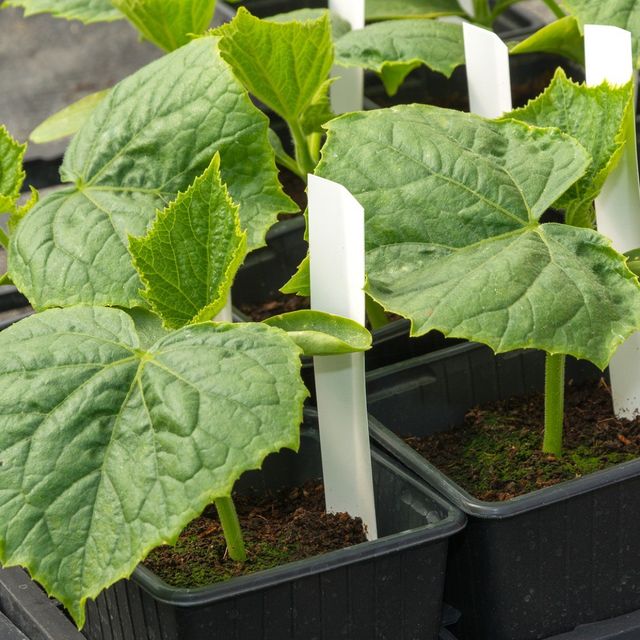
The Seed Selection for cucumber container gardening is a crucial step that can make or break your cucumber-growing success. As a seasoned cucumber container gardener, I’m delighted to share my expert insights on this topic. Let’s dive right in!
Opt for Certified Seeds:
When choosing cucumber seeds for your container garden, always opt for certified seeds from reputable suppliers or seed companies. Certified seeds undergo rigorous testing to ensure their quality and germination rates. This way, you can be confident that you’re starting your cucumber journey with the best possible seeds.
Take the time to read the seed descriptions provided by the supplier or on the seed packet. Seed descriptions contain valuable information about the cucumber variety’s growth habits, fruit size, taste profile, and even days to maturity. This information will help you make an informed decision and select the best cucumber seeds for your container garden.
Consider Your Cucumber Variety:
Cucumbers come in various varieties, each with its unique traits and flavors. Decide whether you want to grow slicing cucumbers for fresh salads or pickling cucumbers for delicious homemade pickles. Understanding the characteristics of different cucumber types will help you select the perfect seeds to suit your culinary preferences.
Disease Resistance:
Cucumber plants can be susceptible to certain diseases, such as powdery mildew and cucumber mosaic virus. Look for seeds that are labeled as disease-resistant to ensure your container garden is better equipped to fend off potential threats. Disease-resistant cucumber varieties give your plants a fighting chance, even during challenging growing seasons.
Know Your Climate:
Cucumbers are sensitive to temperature and sunlight. Before purchasing seeds, be mindful of your local climate and the average temperature in your region. Some cucumber varieties thrive in hotter climates, while others prefer cooler temperatures. Picking seeds that align with your climate ensures your cucumber plants will be happier and healthier.
Hybrid vs. Heirloom Seeds:
You’ll come across two primary types of cucumber seeds – hybrid and heirloom. Hybrid seeds result from crossbreeding different parent plants, offering specific characteristics and uniformity in growth. On the other hand, heirloom seeds are open-pollinated, passed down through generations, and boast a rich history. Choose the seed type that aligns with your gardening goals and preferences.
The seed selection process for cucumber container gardening requires careful consideration of certified seeds, disease resistance, climate suitability, and seed types. Reading seed descriptions and embracing experimentation will add excitement to your gardening experience.
Tip 3- Get The Best Potting Soil For Growing Cucumbers In Containers From Seed
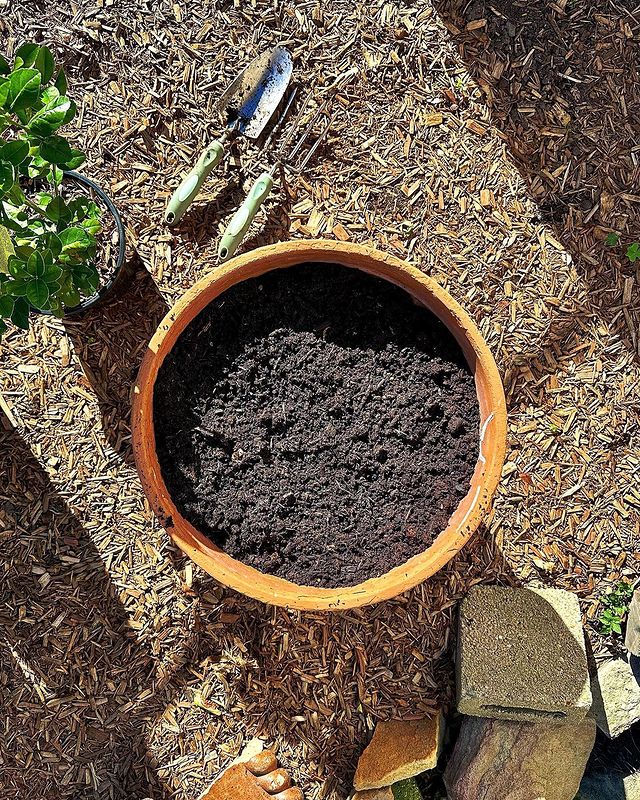
Soil, the Bedrock of Growth, is a critical aspect of successful cucumber container gardening. I will guide you through the right potting mix for growing cucumbers from seeds in containers. Let’s get our hands dirty!
Lightweight and Well-Draining Soil:
The best potting soil for cucumbers must be lightweight and well-draining. Look for a mix that contains ingredients like perlite or vermiculite, as they create air pockets in the soil, allowing excess water to escape easily. This prevents waterlogging and keeps your cucumber roots happy and healthy.
Nutrient-Rich Organic Matter:
Cucumbers are hungry plants, and they need a potting soil rich in organic matter. Seek out mixes that contain compost, well-rotted manure, or other organic materials. These ingredients provide a steady supply of essential nutrients, promoting robust growth and a prolific yield.
pH Balanced:
Cucumbers prefer slightly acidic to neutral soil with a pH range of 6.0 to 7.0. To ensure the best results, choose a potting soil with a pH within this range. A balanced pH allows your cucumber plants to efficiently absorb nutrients, setting them up for success.
Avoid Garden Soil:
Resist the temptation to use garden soil alone for your cucumber containers. Garden soil can be heavy and may not provide the necessary drainage cucumber plants crave. Additionally, it might contain pests or diseases that could harm your cucumbers. Stick to a quality potting mix formulated for container gardening.
Moisture Retentive:
While good drainage is crucial, the best potting soil for cucumbers also retains some moisture to keep your plants hydrated. Look for a mix that strikes the right balance between drainage and moisture retention. This way, your cucumber plants won’t go thirsty, but their roots won’t be waterlogged either.
Fertilizer Enriched:
For an extra boost, consider a potting soil enriched with slow-release fertilizer. This provides a steady supply of nutrients over time, reducing the need for frequent feeding. Just be sure not to overdo it, as cucumbers can be sensitive to excessive fertilization.
Tip 4 – Sunshine Serenade
Sunshine Serenade is music to the ears of cucumber container gardeners! Let’s dive into why sunlight is the key to a successful cucumber dance party and how to find the perfect sunny spot for your cucumber plants.
The Sun-Worshipping Cucumbers:
Cucumbers are sun-worshippers, and they thrive when basking in the warm embrace of sunlight. Sunlight is the ultimate energy source for plants, fueling the process of photosynthesis, where cucumbers convert light into energy to grow and produce fruits. So, the more sun they get, the more they’ll flourish!
Seeking the Sunshine:
When choosing a spot for your cucumber containers, aim for a location that receives ample sunlight. Cucumbers love soaking up 6-8 hours of direct sunlight daily, so scout your balcony, patio, or windowsill for the sunniest spot possible.
South-Facing Glory:
If you’re blessed with a south-facing area, that’s cucumber heaven! South-facing spots typically receive the most sunlight throughout the day, providing your cucumber plants with an abundance of light to thrive. But fear not if you have a different exposure – even east or west-facing areas can still provide sufficient sunlight for cucumbers to perform their dance.
Watch Out for Shade:
While cucumbers adore sunlight, they’re not fans of constant shade. Avoid placing your cucumber containers in spots shadowed by tall buildings, trees, or other obstacles. Consistent shade can hamper their growth and reduce their yield, leaving them with less energy to dance their way to a bountiful harvest.
Embrace Container Mobility:
Container gardening offers a fantastic advantage – mobility! If you find your cucumbers are missing out on the sun’s serenade in their current spot, don’t hesitate to move them around. Containers with wheels are incredibly convenient for shifting your cucumber dance party to catch the sun’s rays throughout the day.
Watch Out for Heat Stress:
While cucumbers crave sunlight, they’re also sensitive to scorching heat. On extremely hot days, consider providing some shade during the peak afternoon hours to prevent heat stress. A simple shade cloth or moving your containers to a slightly shadier spot can do the trick.
Tip 5 – Water, but Don’t Drown
The key to a thriving cucumber container garden is finding the perfect balance between keeping your cucumbers hydrated and avoiding waterlogging. let’s explore the art of watering your cucumber plants with just the right amount of H2O love!
The Watering Goldilocks Zone:
Cucumbers are like Goldilocks; they prefer their water just right – not too much and not too little. Overwatering can lead to waterlogged soil, suffocating your cucumber roots and causing them to rot. On the other hand, underwatering can stress your cucumbers and lead to reduced fruit production. Finding the sweet spot for watering is the secret to cucumber happiness.
Watering Frequency:
How often you water your cucumber containers depends on various factors like the weather, container size, and the stage of plant growth. As a general rule, check the moisture level of the soil regularly by sticking your finger about an inch deep into the soil. If it feels dry, it’s time to water. During hot summer days, your cucumbers may need watering more frequently to stay hydrated.
Deep Watering vs. Light Sprinkling:
When watering your cucumbers, aim for deep watering rather than light sprinkling. Deep watering encourages cucumber roots to grow deeper into the soil, making them more resilient to heat and drought. A thorough watering session helps establish a robust root system, ensuring your cucumbers have a strong foundation for growth.
Morning Love, Evening Caution:
Watering your cucumber plants in the morning is generally ideal. It allows the leaves to dry out during the day, reducing the risk of fungal diseases that thrive in damp conditions. Avoid watering your cucumbers late in the evening, as wet foliage overnight can promote disease development.
Drainage is Key:
Remember Tip 3 – well-draining soil? Well, it plays a crucial role in proper water management too. Containers with good drainage ensure excess water can escape, preventing waterlogging. If your containers lack drainage holes, consider adding some to keep your cucumbers’ roots happy and healthy.
Mulch Magic:
Mulching around your cucumber plants can be a game-changer for water retention. A layer of organic mulch, like straw or wood chips, helps retain soil moisture, reducing the need for frequent watering. Plus, it keeps the soil temperature stable, providing extra benefits to your cucumber dance party.
Watering your cucumber container garden is all about finding the perfect balance. Regularly check the soil moisture, water deeply, and aim for morning watering to keep your cucumber plants hydrated and happy. Ensure good drainage and consider mulching to conserve moisture and maintain soil health. By mastering the art of watering, you’ll be nurturing a cucumber dance party that’ll leave you with a spectacular yield of delicious, homegrown cucumbers.
Tip 6 – Fertilizer Fiesta: Nourishing Your Cucumber Garden!
Alright, it’s time to shake things up with a Fertilizer Fiesta for your cucumber garden! Get ready to salsa with nutrients and cha-cha-charge your cucumber plants with the perfect plant food. Let’s groove into the world of fertilizers like true gardening dance enthusiasts!
The Nutrient Dance:
Cucumbers, like all plants, need a proper balance of nutrients to thrive. The three primary nutrients essential for their growth are nitrogen (N), phosphorus (P), and potassium (K), represented by the three numbers on fertilizer labels. Nitrogen promotes lush foliage, phosphorus aids in root development and flower formation, and potassium boosts overall plant health and fruit production.
Soil Test and Feed Smart:
Before you start the fertilizer fandango, it’s wise to conduct a soil test to gauge the nutrient levels in your container garden. A soil test reveals any deficiencies or excesses, helping you determine the best fertilizer blend for your cucumber plants. Overfertilizing can lead to nutrient imbalances and adversely affect plant health.
Slow and Steady Wins the Race:
When it comes to fertilizing cucumbers, slow-release fertilizers are the preferred dance partners. Slow-release fertilizers provide a continuous and steady supply of nutrients to your cucumber plants over time. This approach prevents nutrient spikes and minimizes the risk of overfeeding.
Mindful Feeding Schedule:
Establish a mindful feeding schedule for your cucumber container garden. Generally, it’s best to start feeding your cucumbers when they’ve developed their first true leaves. Feed them every two to three weeks throughout the growing season. During the early stages, focus on balanced fertilizers with higher nitrogen to encourage healthy leafy growth. As the plants flower and set fruit, shift to fertilizers with a higher phosphorus and potassium content to support fruit development.
Watch for Signs of Overfertilizing:
Just like dance partners, cucumbers can let you know when they’ve had enough. Watch for signs of overfertilizing, such as burnt leaf edges, wilting despite adequate water, or stunted growth. If you notice these signs, it’s time to take a step back and ease up on the fertilizer.
Compost and Organic Alternatives:
For an organic fandango, consider using compost as a natural fertilizer for your cucumber plants. Compost enriches the soil with essential nutrients, promotes soil health, and encourages beneficial microorganisms. Organic alternatives, like fish emulsion or seaweed extracts, can also provide a nutrient boost without the risk of overfertilizing.
The fertilizer fandango is all about finding the perfect balance in feeding your cucumber container garden. Perform a soil test to identify any nutrient deficiencies, choose slow-release fertilizers, and establish a mindful feeding schedule. Be attentive to signs of overfeeding and consider organic alternatives for an eco-friendly dance with your cucumber plants. With the right nutrient dance moves, your cucumber babies will be in top form, putting on a show-stopping performance with a bountiful harvest of scrumptious cucumbers.
Tip 7 – Trellis Tango: Taming Your Cucumber Vines!
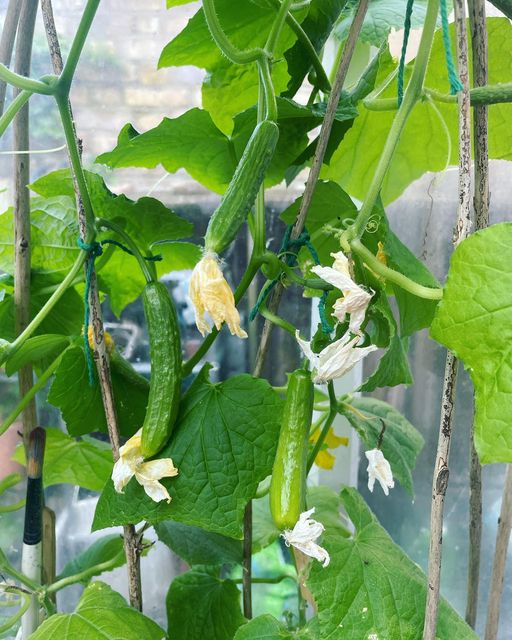
Step onto the dance floor of trellis tango, where we’ll explore the art of training your cucumber vines to gracefully climb and twirl. Cucumbers might be a wild bunch, but with trellis guidance, you’ll master the elegant dance of cucumber yoga. Let’s unravel the steps to taming those unruly vines and turning them into dancing stars!
Partner Up with a Trellis:
As your cucumber plants grow, they’ll start reaching out for something to hold onto – enter the trellis! A trellis is like the perfect dance partner for your cucumber vines, providing the necessary support and structure they need to grow vertically. Choose a sturdy and tall trellis that can accommodate the full height of your cucumber plants.
Gentle Guidance:
In the world of trellis tango, gentle guidance is key. Encourage your cucumber vines to embrace the trellis by gently coaxing them towards it. You can train the young tendrils to grip onto the trellis or gently weave them through the openings. Avoid forceful movements or pulling, as cucumber vines prefer a more delicate dance.
Trellis Placement:
Position the trellis strategically to entice your cucumber vines to embrace it. Place it on the sunny side of your cucumber containers, where the vines can enjoy the warmth of the sun while dancing up the trellis. The right placement sets the stage for a beautiful dance performance of cucumber yoga.
Tie the Knot:
Secure the cucumber vines to the trellis with soft ties or plant clips. This act of trellis tango ensures that your vines stay on course and follow the dance steps up the trellis. Be gentle with the ties, allowing room for the vines to grow without constricting them.
Pruning with Precision:
As your cucumber plants tango with the trellis, keep a watchful eye on excessive growth. Pruning is like the fine-tuning of the dance steps. Remove any side shoots or branches that may divert the energy from the main stem. Pruning helps your cucumber plants focus their energy on fruit production, leading to a more fruitful tango.
Twirling and Tendrils:
Cucumber vines have a way of exploring and twirling with their curly tendrils. Embrace their natural dance moves and gently guide these tendrils towards the trellis. As they loop around the trellis, it’s like cucumber yoga in action – a graceful and enchanting dance of growth.
Tip 8 – Pest Control: Safeguarding Your Cucumber
Welcome to the Critter-Free Carnival, where we’ll shou how to protect your cucumbers from pesky pests and ensure your garden party remains pest-proof! No uninvited guests allowed at this party! Get ready to explore natural pest repellen
- Set Up a Pest-Proof Perimeter: As the host of the Critter-Free Carnival, establish a pest-proof perimeter around your cucumber garden. Create a physical barrier using row covers or netting to keep insects and larger critters at bay. This simple step ensures your cucumbers can enjoy their party without unwanted visitors.
- Beneficial Bug Allies: Invite some beneficial bug allies to the carnival! Ladybugs, lacewings, and praying mantises are like the VIP guests that can help control harmful pests naturally. These beneficial insects feast on common cucumber pests like aphids and caterpillars, keeping the pest population in check without the need for harmful chemicals.
- Essential Oil Extravaganza: Lure your cucumber-loving guests with an essential oil extravaganza! Certain essential oils, like neem oil, peppermint oil, and garlic oil, act as natural pest repellents. Mix a few drops with water and spray the solution on your cucumber plants to discourage pests from crashing the carnival.
- Companion Planting Parade: Host a companion planting parade and surround your cucumber plants with pest-repelling companions. Marigolds, nasturtiums, and basil are excellent companions that emit scents that deter pests. Plus, they add a splash of color to the carnival atmosphere!
- Sticky Trap Dancefloor: Lay out the sticky trap dancefloor for flying pests! Sticky traps are like the dance partners that attract and trap flying insects like whiteflies and fruit flies. Place these traps strategically around your cucumber containers to catch those pesky party crashers.
- Nighttime Pest Patrol: Don’t forget the nighttime pest patrol! Some pests prefer the cover of darkness, so take a stroll through your garden at night with a flashlight to spot any nocturnal intruders. Handpick pests like slugs and snails to keep their numbers in check.
Tip 9 – Tip 9 – Trimming Triumph: Mastering the Art of Pruning

Get ready for a trimming triumph as we embark on a Trim and Thrive Extravaganza! It’s time to showcase the art of pruning to enhance your cucumber garden’s beauty and productivity. Bid farewell to excess leaves and embrace the magic of well-pruned cucumber plants that will flourish like rockstars on the garden stage. Let’s dive into the steps of the Trim and Thrive Extravaganza!
- Pruning Purpose: At the heart of the Trimming Triumph is understanding the purpose of pruning. Pruning is like sculpting for your cucumber plants, removing excess foliage to promote better air circulation and sunlight penetration. This dance of snip-snip enhances fruit development, leading to a more prolific harvest.
- Identify Excess Growth: Put on your pruning glasses and identify the areas with excess growth. Look for dense foliage, crowded leaves, and any yellowing or dead leaves that need to be removed. These are like the untamed dance moves that need some trimming for a sleek performance.
- Bye-Bye Basal Leaves: Start the Trimming Triumph by saying goodbye to the basal leaves – those close to the ground. Removing these leaves keeps them from touching the soil, preventing the risk of disease and rot. A bit of strategic snip-snip helps your cucumber plants keep their feet dry and healthy.
- Focus on the Fruit: Prune with the goal of fruit production in mind. Trim away any lateral branches that compete for energy and nutrients, redirecting the plant’s focus towards fruit development. This is like the choreography for the star act – your cucumbers’ journey towards producing delicious fruits.
- Create Airy Aisles: Imagine your cucumber garden as a dance floor, and your plants need some space to move freely. Create airy aisles by thinning out excess leaves and branches. Adequate spacing allows air to flow around the plants, reducing the risk of fungal diseases and promoting a vibrant dance of growth.
- Be Gentle and Watchful: Pruning is an art, and the Trimming Triumph requires a gentle touch. Use sharp and clean pruning shears to make precise cuts, avoiding any tearing or damage to the plant. Be watchful as you prune, ensuring you remove only what’s necessary while preserving the overall health of your cucumber plants.
Trimming is all about mastering the art of pruning to promote healthier cucumber plants and a bountiful harvest. Understand the purpose of pruning, identify excess growth, and focus on fruit development. Say goodbye to basal leaves, create airy aisles, and be gentle and watchful as you prune.
Tip 10 – Harvest Delight: The Joyous Cucumber Celebration!

At long last, the time has come for the ultimate cucumber celebration – Harvest Delight! Get ready to pick those cucumbers at their peak of ripeness, and prepare yourself for a joyous dance of flavors that will set your taste buds spinning! Let’s explore the steps to the Harvest Delight and savor the rewards of your cucumber container garden.
- Timing is Key: Timing is everything in the Harvest Delight dance. Pick your cucumbers when they reach their ideal size and color, depending on the variety you’re growing. For slicing cucumbers, this is usually when they’re about 6 to 8 inches long, while pickling cucumbers are best when they’re smaller, around 2 to 4 inches. Don’t wait too long or let them become overripe; cucumbers taste best when harvested at their peak.
- Snip or Snap: How you harvest your cucumbers depends on the type of cucumber and your preference. For slicing cucumbers, use a sharp knife or pruning shears to snip them from the vine, leaving a short stem attached. For pickling cucumbers, gently snap them off the vine by hand, again leaving a small stem. Be careful not to damage the vines or nearby fruits during the harvest dance.
- Harvest Frequently: Keep the Harvest Delight dance party going by harvesting your cucumbers frequently. The more you pick, the more your cucumber plants will produce! Aim to harvest cucumbers every few days, as ripe cucumbers can quickly turn into overripe ones if left on the vine too long.
- Taste the Happiness: As you bite into the freshly harvested cucumbers, get ready for a taste explosion that will make your taste buds boogie with delight! Homegrown cucumbers are bursting with flavor and have a crispness that store-bought ones can’t match. This is the moment when all your hard work and dedication to your cucumber container garden pay off in the most delicious way.
- Share the Bounty: The Harvest Delight isn’t complete without sharing the bounty with friends, family, and neighbors. Spread the joy and share the delicious cucumbers with loved ones, letting them experience the happiness of homegrown cucumbers too.
Time your harvests perfectly, using snips or snaps to gather the ripe cucumbers. Harvest frequently to encourage more production, and savor the incredible flavors that your cucumbers offer. Share the joy of your cucumber bounty with others, and relish in the satisfaction of a successful cucumber container garden.
